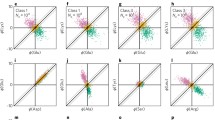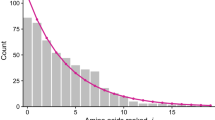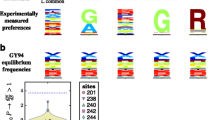Summary
Based on the rates of amino acid substitution for 60 mammalian genes of 50 codons or more, it is shown that the rate of amino acid substitution of a protein is correlated with its amino acid composition. In particular, the content of glycine residues is negatively correlated with the rate of amino acid substitution, and this content alone explains about 38% of the total variation in amino acid substitution rates among different protein families. The propensity of a polypeptide to evolve fast or slowly may be predicted from an index or indices of protein mutability directly derivable from the amino acid composition. The propensity of an amino acid to remain conserved during evolutionary times depends not so much on its being features prominently in active sites, but on its stability index, defined as the mean chemical distance [R. Grantham (1974) Science 185∶862–864] between the amino acid and its mutational derivatives produced by single-nucleotide substitutions. Functional constraints related to active and binding sites of proteins play only a minor role in determining the overall rate of amino acid substitution. The importance of amino acid composition in determining rates of substitution is illustrated with examples involving cytochrome c, cytochrome b5,ras-related genes, the calmodulin protein family, and fibrinopeptides.
Similar content being viewed by others
References
Baba ML, Darga LL, Goodman M, Czelusniak J (1981) Evolution of cytochrome c investigated by the maximum parsimony method. J. Mol Evol 17:197–213
Baba ML, Goodman M, Berger-Cohn J, Demaille JG, Matsuda G (1984) The early adaptive evolution of calmodulin.Mol Biol Evol 1:442–455
Clarke B (1970) Selective constraints on amino-acid substitutions during the evolution of proteins. Nature 228:159–160
Dayhoff MO (ed) (1972) Atlas of protein sequence and structure, vol 5. National Biomedical Research Foundation, Silver Spring, Maryland
Dayhoff MO (ed) (1976) Atlas of protein sequence and structure, vol 5, suppl 2. National Biomedical Research Foundation, Washington, DC
Dayhoff MO (ed) (1978) Atlas of protein sequence and structure vol 5, suppl 3. National Biomedical Research Foundation, Washington, DC
Dayhoff MO, Hunt LT, Barker WC, Orcutt BC, Yeh LS, Chen HR, George DG, Blomquist MC, Johnson GC (1983) Protein sequence database (June release). National Biomedical Research Foundation. Washington, DC
DeFeo-Jones D, Scolnick EM, Koller R, Dhar R (1983)ras-Related gene sequences identified and isolated fromSaccharomyces cerevisiae. Nature 306:707–709
Dickerson RE (1971) The structure of cytochrome c and the rates of molecular evolution. J Mol Evol 1:26–45
Doolittle RF (1979) Protein evolution. In: Neurath HD (ed) The proteins. Academic Press, New York, pp 1–118
French S, Robson B (1983) What is a conservative substitution? J Mol Evol 19:171–175
Gallwitz D, Donath C, Sander C (1983) A yeast gene encoding a protein homologous to the human c-has/has proto-oncogene product. Nature 306:704–707
Gojobori T, Nei M (1984) Concerted evolution of the immunoglobulin VH gene family. Mol Biol Evol 1:195–212
Gojobori T, Li W-H, Graur D (1982) Patterns of nucleotide substitution in pseudogenes and functional genes. J Mol Evol 18:360–369
Grantham R (1974) Amino acid difference formula to help explain protein evolution. Science 185:862–864
Graur D (1985) Pattern of nucleotide substitution and the extent of purifying selection in retroviruses. J Mol Evol 21:221–231
Grütter MG, Hawkes RB (1983) Mutation and the conformational stability of globular proteins. Naturwissenschaften 70:434–438
Jukes TH, King JL (1971) Deleterious mutations and neutral substitutions. Nature 231:114–115
Jukes TH, King JL (1979) Evolutionary nucleotide replacements in DNA. Nature 281:605–606
Kimura M (1983) The neutral theory of molecular evolution. Cambridge University Press. Cambridge
Kimura M, Ohta T (1974) On some principles governing molecular evolution. Proc Natl Acad Sci USA 71:2848–2852
Lehninger AL (1975) Biochemistry. Worth Publishers, New York
Li W-H, Gojobori T, Nei M (1981) Pseudogenes as a paradigm of neutral evolution. Nature 292:237–239
Li W-H, Wu, C-I, Luo C-C (1985) A new method for estimating synonymous and nonsynonymous rates of nucleotide substitution considering the relative likelihood of nucleotide and codon changes. Mol Biol Evol 2, in press
Marshall DR, Brown AHD (1975) The charge-state model of protein polymorphism in natural populations. J Mol Evol 6: 149–163
Miyata T, Miyazawa S, Yasunaga T (1979) Two types of amino acid substitution in protein evolution. J Mol Evol 12:219–236
Miyata T, Yasunaga T, Nishida T (1980) Nucleotide sequence divergence and functional constraint in mRNA evolution. Proc Natl Acad Sci USA 77:7328–7332
Nei M (1975) Molecular population genetics and evolution. North-Holland, Amsterdam
Nei M, Koehn RK (1983) Evolution of genes and proteins. Sinauer, Sunderland, Massachusetts
Newmark P (1983) Morerasmatazz. Nature 306:642
Nie NH, Hull CH, Jenkins JG, Steinbrenner K, Bent DH (1975) SPSS. McGraw-Hill, New York
Shilo B-Z, Weinberg RA (1981) DNA sequences homologous to vertebrate oncogenes are conserved inDrosophila melanogaster. Proc Natl Acad Sci USA 78:6789–6791
Sneath PHA (1966) Relations between chemical structure and biological activity in peptides. J Theor Biol 12:157–195
Sokal RR, Rohlf FJ (1969) Biometry. WH Freeman, San Francisco
Taniguchi T, Mantei N, Schwarzstein M, Nagata S, Muramatsu M, Weissmann C (1980) Human leukocyte and fibroblast interferons are structurally related. Nature 285:547–549
Valenzuela D, Weber H, Weissmann C (1985) Is sequence conservation in interferons due to selection for functional proteins? Nature 313:698–700
Wu C-I, Li W-H (1985) Evidence for higher rates of nucleotide substitution in rodents than in man. Proc Natl Acad Sci USA 82:1741–1745
Zuckerkandl E (1976) Evolutionary processes and evolutionary noise at the molecular level. I. Functional density in proteins. J Mol Evol 7:167–183
Author information
Authors and Affiliations
Rights and permissions
About this article
Cite this article
Graur, D. Amino acid composition and the evolutionary rates of protein-coding genes. J Mol Evol 22, 53–62 (1985). https://doi.org/10.1007/BF02105805
Received:
Revised:
Issue Date:
DOI: https://doi.org/10.1007/BF02105805




